Accounting for Greenhouse Gas Emissions in the Agricultural System of China Based on the Life Cycle Assessment Method
Abstract
:1. Introduction
2. Materials and Methods
2.1. Definition of the Study Area
2.2. Life Cycle Assessment Methodology
2.3. Carbon Footprint Accounting Methods
- (1)
- The carbon footprints of rice, wheat, and corn are calculated by considering various agricultural materials such as seeds, nitrogen fertilizers, phosphorus fertilizers, potash fertilizers, compound fertilizers, pesticides, and agricultural films. Additionally, the energy emissions include the diesel fuel consumed by agricultural machinery and electricity used for irrigation. It is important to note that CO2 emissions from the direct consumption of fossil fuels and electricity during raw material extraction are not counted twice, since the emission factor accounts for this portion in the direct energy consumption of the agricultural production process.
| Carbon Sources | Carbon Emission Coefficients | Unit | Coefficient Source |
|---|---|---|---|
| Seeds | Rice: 1.84 Wheat: 0.58 Corn: 1.93 | kgCO2-eq/kg | ecoinvent 2.2 [43] |
| Nitrogen fertilizers | 1.53 | CLCD 0.7 [44] | |
| Phosphorus fertilizers | 1.63 | ||
| Potash fertilizers | 0.65 | ||
| Compound fertilizers | 1.77 | ||
| Pesticides | 18.09 | [45] | |
| Agricultural films | 22.72 | CLCD 0.7 [44] | |
| Diesel fuel burning | 0.89 | ||
| Electricity for irrigation | Northwestern: 0.97 | kgCO2-eq/3.6 MJ | |
| North China: 1.23 | |||
| South China: 0.82 |
- (2)
- Formula for calculating CH4 emissions from enteric fermentation in animals:
2.4. Data Sources
3. Results
3.1. Time-Series Characterization of Agricultural Greenhouse Gas Emissions
3.2. Characterization of the Structure of Greenhouse Gas Emissions from Agriculture
3.2.1. Characterization of the Emission Structure of Diverse Food Crops and Livestock Species
3.2.2. Characterizing the Emissions Structure Arising from Diverse Agricultural Production Activities
3.2.3. Characterizing the Emissions Structure Arising from Cultivation and Animal Husbandry
3.3. Spatial Distribution of Agricultural Greenhouse Gas Emissions
4. Discussion
- (1)
- Reducing CH4 emissions is the central focus of the United Nations Framework Convention on Climate Change (UNFCCC) in 2021. Given that CH4 is the primary greenhouse gas emitted by agricultural activities, addressing its reduction entails improving rice varieties and optimizing the rice production layout in China, especially in the middle and lower reaches of the Yangtze River plains and other major rice-growing areas. This involves selecting and breeding adapted rice varieties, reasonably managing paddy field moisture, and adopting intermittent irrigation instead of flooding to alleviate the pressure of CH4 emissions resulting from rice cultivation [52]. Meanwhile, CH4 emissions from animal enteric fermentation are mainly influenced by factors such as the animal’s body weight, type, and age, along with feed quality and the intake level [53]. Ruminants exhibit high levels of CH4 emissions through enteric fermentation. Therefore, it is recommended to improve feed quality and emphasize a balanced combination of coarse and fine feeds in their diet to effectively mitigate animal-derived methane emissions [54].
- (2)
- Crop straw burning is a major contributor to agricultural CO2 emissions, as highlighted in the Circular of the State Council on the Action Program for Carbon Peak by 2030 issued in 2021. To effectively address this issue, it is imperative to enhance the comprehensive utilization of agricultural straw. Particularly, emphasis should be placed on elevating straw utilization levels in dryland crop-dominated regions such as Northeast China and North China, with the aim of minimizing straw burning and achieving substantial reductions in agricultural CO2 emissions.
- (3)
- Agricultural N2O mainly originates from the application of nitrogen fertilizer to crops and the management of animal manure. To mitigate greenhouse gas emissions resulting from excessive fertilizer usage, it is recommended to strictly regulate the amount of nitrogen fertilizer applied, enhance nitrogen fertilizer utilization efficiency through a rational nutrient distribution ratio, and elevate scientific fertilization practices. In addition, it is imperative for the Inner Mongolia Plateau, Xinjiang, and other important livestock breeding areas in China to strengthen their manure management and optimize appropriate management measures. This includes prioritizing the establishment of biogas projects as an alternative to the conventional accumulation of animal waste for centralized treatment and recycling. Additionally, continuous efforts should be made to promote the expansion of large-scale animal husbandry operations, thereby effectively mitigating greenhouse gas emissions.
- (4)
- In terms of the spatial distribution of planting and livestock species, it is advisable to ensure a rational allocation of agricultural resources and strategically plan crop cultivation and livestock breeding based on local conditions. The main grain-producing regions should enhance soil moisture management and optimize the efficiency of straw utilization, with a primary focus on soil preservation. In addition, for livestock breeding areas like Inner Mongolia in China, it is crucial to scientifically plan the scale of livestock production while emphasizing the quality and quantity of animal feed intake. These measures aim to propel China’s agricultural sector towards sustainable development and effectively mitigate greenhouse gas emissions in agriculture. In the future, when formulating emission reduction policies, it is crucial to fully consider the spatial agglomeration characteristics of different regions. For regions with high emissions concentration, such as the North China Plain, emphasis should be placed on optimizing the agricultural structure, enhancing the efficiency of resource utilization, reducing unnecessary energy consumption and emissions, and strengthening the research and development, as well as the promotion of agricultural production technologies. It is essential to strengthen interregional cooperation and exchanges while sharing experiences in emission reduction in order to jointly promote national agricultural GHG emission reduction.
5. Conclusions
- (1)
- From 2000 to 2020, China’s total agricultural GHG emissions generally show a fluctuating upward trajectory. Notably, CH4 emissions from the agricultural sector constituted the largest share but had a relatively gradual growth rate. Agricultural CO2 emissions ranked as the second largest in magnitude and experienced the most rapid increase over time. Conversely, agricultural N2O emissions were comparatively smaller and showed a decreasing trend. There exists a strong correlation between the trend of agricultural GHG emissions and a series of pertinent national policies and events (Table 8) that have played a significant role in either promoting or inhibiting agricultural GHG emissions.
- (2)
- In terms of the composition of GHG emissions, there has been an overall upward trend in GHG emissions from cultivation between 2000 and 2020. CH4 emissions from rice cultivation have emerged as the largest contributor. The livestock sector has witnessed a decline in GHG emissions due to improved management techniques and increased adoption of large-scale production methods. The primary sources of GHG emissions in the sector include enteric fermentation and manure management.
- (3)
- The spatial distribution of agricultural GHG emissions exhibits substantial variations that are closely associated with both the level of regional development and production methods. Areas with high agricultural CH4 emissions are mainly concentrated in China’s key rice-growing regions, including the middle and lower plains of the Yangtze River and the Pearl River Basin. Additionally, these emissions are prevalent in livestock breeding areas such as Inner Mongolia.
- (4)
- The primary source of agricultural CO2 emission stems from burning of crop straw, thus rendering Northeast China and the North China plains, renowned for their dryland crop production, as regions with elevated agricultural CO2 emission. The areas characterized by substantial agricultural N2O emissions areas are gradually concentrated within China’s livestock breeding zones, such as Inner Mongolia, and major grain-producing areas, such as the North China Plain.
Author Contributions
Funding
Institutional Review Board Statement
Informed Consent Statement
Data Availability Statement
Conflicts of Interest
References
- Wu, P.; Zhao, X. Impact of Climate Change on Agricultural Water Use and Food Production in China. Trans. CSAE 2010, 26, 1–6. [Google Scholar]
- Kiehl, J.; Trenberth, K. Earth’s Annal Global Mean Energy Budget. Bull. Am. Meteorol. Soc. 1997, 78, 197–208. [Google Scholar] [CrossRef]
- Sun, Y.; Zhang, X.; Shi, X. Voluntary cooperation mechanism of global climate governance and China’s participation strategy—Taking article 6 of the Paris Agreement as an example. Tianjin Soc. Sci. 2022, 4, 93–99. [Google Scholar] [CrossRef]
- Ofipcc, W. Climate Change 2013: The Physical Science Basis. Contrib. Work. 2013, 43, 866–871. [Google Scholar] [CrossRef]
- IPCC. Climate Change 2021: The Physical Science Basis Available. Available online: https://www.ipcc.ch/report/ar6/wg1/ (accessed on 11 January 2024).
- Tubiello, F.N.; Salvatore, M.; Rossi, S.; Ferrara, A.; Fitton, N.; Smith, P. The FAOSTAT database of greenhouse gas emissions from agriculture. Environ. Res. Lett. 2013, 8, 015009. [Google Scholar] [CrossRef]
- Ministry of Ecology and Environment of the People’s Republic of China. The People’s Republic of China Third National Communication on Climate Change. Available online: https://www.mee.gov.cn/ywgz/ydqhbh/wsqtkz/201907/P020190701762678052438.pdf (accessed on 10 January 2024).
- Ran, G.; Wang, J.; Wang, D. Study on the changing trend of carbon emissions in modern agricultural production in China. Issues Agric. Econ. 2011, 32, 32–38+110–111. [Google Scholar] [CrossRef]
- Tian, Y.; Zhang, J. Regional differentiation research on net carbon effect of agricultural production in China. J. Nat. Resour. 2013, 28, 1298–1309. [Google Scholar]
- Li, B.; Zhang, J.; Li, H. Empirical study on China’s agriculture carbon emissions and economic development. J. Arid. Land Resour. Environ. 2011, 25, 8–13. [Google Scholar] [CrossRef]
- Tan, Q. Greenhouse gas emission in China’s agriculture: Situation and challenge. China Popul. Resour. Environ. 2011, 21, 69–75. [Google Scholar]
- Min, J.; Hu, H. Calculation of greenhouse gases emission from agricultural production in China. China Popul. Resour. Environ. 2012, 22, 21–27. [Google Scholar]
- Brodt, S.; Kendall, A.; Mohammadi, Y.; Arslan, A.; Yuan, J.; Lee, I.-S.; Linquist, B. Life cycle greenhouse gas emissions in California rice production. Field Crops Res. 2014, 169, 89–98. [Google Scholar] [CrossRef]
- Wang, X.; Zhao, X.; Wang, Y.; Xue, J.; Zhang, H. Assessment of the carbon footprint of rice production in China. Resour. Sci. 2017, 39, 713–722. [Google Scholar] [CrossRef]
- Wang, Y.Q.; Pu, C.; Zhao, X.; Wang, X.; Liu, S.; Zhang, H. Historical dynamics and future trends of carbon footprint of wheat and maize in China. Resour. Sci. 2018, 40, 1800–1811. [Google Scholar] [CrossRef]
- Hu, X.; Wang, J. Estimation of greenhouse gas emissions from livestock and poultry in China. Trans. CSAE 2010, 26, 247–252. [Google Scholar]
- Al-Mansour, F.; Jejcic, V. A model calculation of the carbon footprint of agricultural products: The case of Slovenia. Energy 2017, 136, 7–15. [Google Scholar] [CrossRef]
- Tian, Y.; Zhang, J.B.; Yin, C.J.; Wu, X. Distributional dynamics and trend evolution of China’s agricultural carbon emissions—An analysis on panel data of 31 provinces from 2002 to 2011. China Popul. Resour. Environ. 2014, 24, 91–98. [Google Scholar] [CrossRef]
- Fan, Z.; Qi, X.; Zeng, L.; Wu, F. Accounting of Greenhouse Gas Emissions of Agricultural System in China in Recent 40 Years. Acta Ecol. Sin. 2022, 42, 9470–9482. [Google Scholar]
- Zhang, M.; Li, W.; Zhang, J.; Huang, H.; Che, X. The accounting of agriculture greenhouse gas emissions in Hainan province. China Popul. Resour. Environ. 2014, 24, 19–23. [Google Scholar]
- Huang, Z.; Mi, S. Study on Agricultural Carbon Footprint—A Case Study of Zhejiang Province. Issues Agric. Econ. 2011, 32, 40–47+111. [Google Scholar]
- Kang, T.; Yang, H.; Guo, R. Accounting of Agricultural Greenhouse Gas Emissions in Chongming County. Resour. Environ. Yangtze Basin 2012, 21, 102–108. [Google Scholar]
- Yao, B.; Zheng, Y.; Hu, D.; Nie, L.; Fu, S.; Hu, Q. Temporal and Spatial Dynamics of Agricultural Carbon Emissions in Counties of Jiangxi Province and Its Influencing Factors. Resour. Environ. Yangtze Basin 2014, 23, 311–318. [Google Scholar]
- Chen, H.; Fu, G.; Liu, Y. Agricultural Greenhouse Gas Emissions in Counties of Jiangsu Province: Temporal and Spatial Differences and Trend Evolution. Resour. Sci. 2018, 40, 1084–1094. [Google Scholar]
- Wu, X.; Zhang, J. Agricultural carbon emissions in China province: Growth leading effect and decoupling effect of emission reduction. J. Agrotech. Econ. 2017, 5, 27–36. [Google Scholar] [CrossRef]
- He, Y.; Dai, X. Phase characteristics and regional differences in agriculture carbon emissions in China. Resour. Sci. 2016, 38, 1780–1790. [Google Scholar] [CrossRef]
- Rochette, P.; E Worth, D.; Huffman, E.C.; A Brierley, J.; McConkey, B.G.; Yang, J.; Hutchinson, J.J.; Desjardins, R.L.; Lemke, R.; Gameda, S.; et al. Estimation of N2O emissions from agricultural soils in Canada. II. 1990–2005 inventory. Can. J. Soil Sci. 2008, 88, 655–669. [Google Scholar] [CrossRef]
- Pang, L. Analysis on Regional Differences and Influencing Factors of Agricultural Carbon Emissions in China. J. Arid Land Resour. Environ. 2014, 28, 1–7. [Google Scholar]
- Li, H.; Qiu, J.; Wang, L.; Ren, T. The characterization of greenhouse gases fluxes from croplands of China and mitigation technologies. Ecol. Environ. Sci. 2012, 21, 159–165. [Google Scholar] [CrossRef]
- Jiang, Z.; Yin, S.; Zhang, X.; Li, C.; Shen, G.; Zhou, P.; Liu, C. Research and Development of a DNDC Online Model for Farmland Carbon Sequestration and GHG Emissions Mitigation in China. Int. J. Environ. Res. Public Health 2017, 14, 1493. [Google Scholar] [CrossRef] [PubMed]
- Wu, X.R.; Zhang, J.B.; Tian, Y.; Li, P. Research on China’s provincial agricultural carbon emissions performance index and its influencing factors. Resour. Sci. 2014, 36, 129–138. [Google Scholar]
- Zhang, X.; Wang, J.; Zhang, T.; Li, B.; Yan, L. N2O Emission Assessment and Low-carbon Measures of Agricultural System in China. Jiangsu J. Agric. Sci. 2021, 37, 1215–1223. [Google Scholar]
- Zhang, F.; Xuan, X.; Jin, G.; Wu, F. Non-carbon dioxide greenhouse gas emissions from agricultural sources and scenario simulation. Acta Geogr. Sin. 2023, 78, 35–53. [Google Scholar]
- Xia, L.; Ti, Z.; Zhu, C.; Zhang, G.; Wei, Z.; Yan, X. Greenhouse gas emission reduction strategy and carbon neutrality path of grain production in China. Acta Pedol. Sin. 2023, 60, 1277–1288. Available online: http://kns.cnki.net/kcms/detail/32.1119.P.20230927.1802.002.html (accessed on 24 November 2023).
- Xia, L.; Yan, X. Research progress and prospect of greenhouse gas emissions from the life-cycle production of food crops in China. J. Agro-Environ. Sci. 2020, 39, 665–672. [Google Scholar]
- Liu, G.; Müller, D.B. Addressing sustainability in the aluminum industry: A critical review of life cycle assessments. J. Clean. Prod. 2012, 35, 108–117. [Google Scholar] [CrossRef]
- Klüppel, H.-J. ISO 14041: Environmental management—Life cycle assessment—Goal and scope definition—Inventory analysis. Int. J. Life Cycle Assess. 1998, 3, 301. [Google Scholar] [CrossRef]
- Wang, M.; Wu, W.; Xia, X. Life cycle environmental impact assessment of summer maize in high-yield grain areas of North China. Acta Sci. Circumstantiae 2010, 30, 1339–1344. [Google Scholar] [CrossRef]
- Li, Z.; Wang, X.; Gao, Z.; Ma, W. Life cycle assessment of environmental impact of wheat fertilization resources in different regions of China. J. Agro-Environ. Sci. 2010, 29, 1417–1422. [Google Scholar]
- Institutioni, B. Specification for the assessment of the life cycle greenhouse gas emissions of goods and services. Bsi Br. Stand. Isbn 2011, 978, 580. [Google Scholar]
- Shi, M.; Wang, Y.; Zhang, Z.; Zhou, X. Carbon Footprint and Spatial Transfer of Carbon Emissions in Provinces of China. Acta Geogr. Sin. 2012, 67, 1327–1338. [Google Scholar]
- Liu, X.H.; Xu, W.W.; Li, Z.J.; Chu, Q.Q.; Yang, X.L.; Chen, B. Carbon Footprint Method of Farmland Ecosystem: Misunderstanding, Improvement and Application—Analysis of Carbon Efficiency of Intensive Farming in China. Chin. J. Agric. Resour. Reg. Plan. 2013, 34, 1–11. [Google Scholar]
- Ecoinvent Database [EB/OL]. Available online: https://www.ecoinvent.ch/ (accessed on 11 January 2024).
- Liu, X.; Wang, H.; Chen, J.; He, Q.; Zhang, H.; Jiang, R.; Chen, X.; Hou, P. Establishment method and basic model of China life cycle reference database. Acta Sci. Circumstantiae 2010, 30, 2136–2144. [Google Scholar] [CrossRef]
- Zhi, J.; Gao, J. Comparative Analysis of Carbon Emissions from Food Consumption of Urban and Rural Residents in China. Prog. Geogr. 2009, 28, 429–434. [Google Scholar]
- Luan, J.; Chou, H.; Jing, Y.; Liao, S.; Han, W. Decomposition of the reasons for the continuous growth of China’s fertilizer application and trend prediction. Resour. Sci. 2013, 28, 1869–1878. [Google Scholar]
- Li, F.; Fu, G.; Mei, Q.; Li, W.; Wang, C. Distribution characteristics of main crop straw resources and current situation of field returning in Hubei Province. J. Yangtze Univ. 2016, 13, 47–51+4. [Google Scholar] [CrossRef]
- Jiang, W.; Zhang, H.; Li, N.; Di, Z.; Cui, Z. Crop straw utilization and equipment status in Shandong Province. J. Chin. Agric. Mech. 2019, 40, 169–174. [Google Scholar] [CrossRef]
- Wu, Y.; Feng, K. Spatialtemporal differentiation features and correlation effects of provincial agricultural carbon emissions in China. Environ. Sci. Technol. 2019, 42, 180–190. [Google Scholar] [CrossRef]
- Luo, D.; Li, W.; Chen, J. Moderate scale of grain production and management: Two-dimensional perspective of output and benefit. J. Manag. World 2017, 1, 78–88. [Google Scholar] [CrossRef]
- Zhang, G.; Wang, S. China’s agricultural carbon emissions:structure, efficiency and its determinants. Issues Agric. Econ. 2014, 35, 18–26+110. [Google Scholar] [CrossRef]
- Wang, Z.; Xu, Y.; Li, Z.; Guo, Y.; Ding, Y.; Wang, Z. Methane emission from paddy fields and its control. Crops 1998, 3, 10–11. [Google Scholar]
- Dong, H.; Li, Y.E.; Tao, X.; Peng, X.; Li, N.; Zhu, Z. China greenhouse gas emissions from agricultural activities and its mitigation strategy. Trans. CSAE 2008, 24, 269–273. [Google Scholar]
- Dong, H.; Lin, E.; Yang, Q. Methane emitted from ruminants in China and the mitigation technologies. Rural Eco-Environ. 1995, 3, 4–7. [Google Scholar]
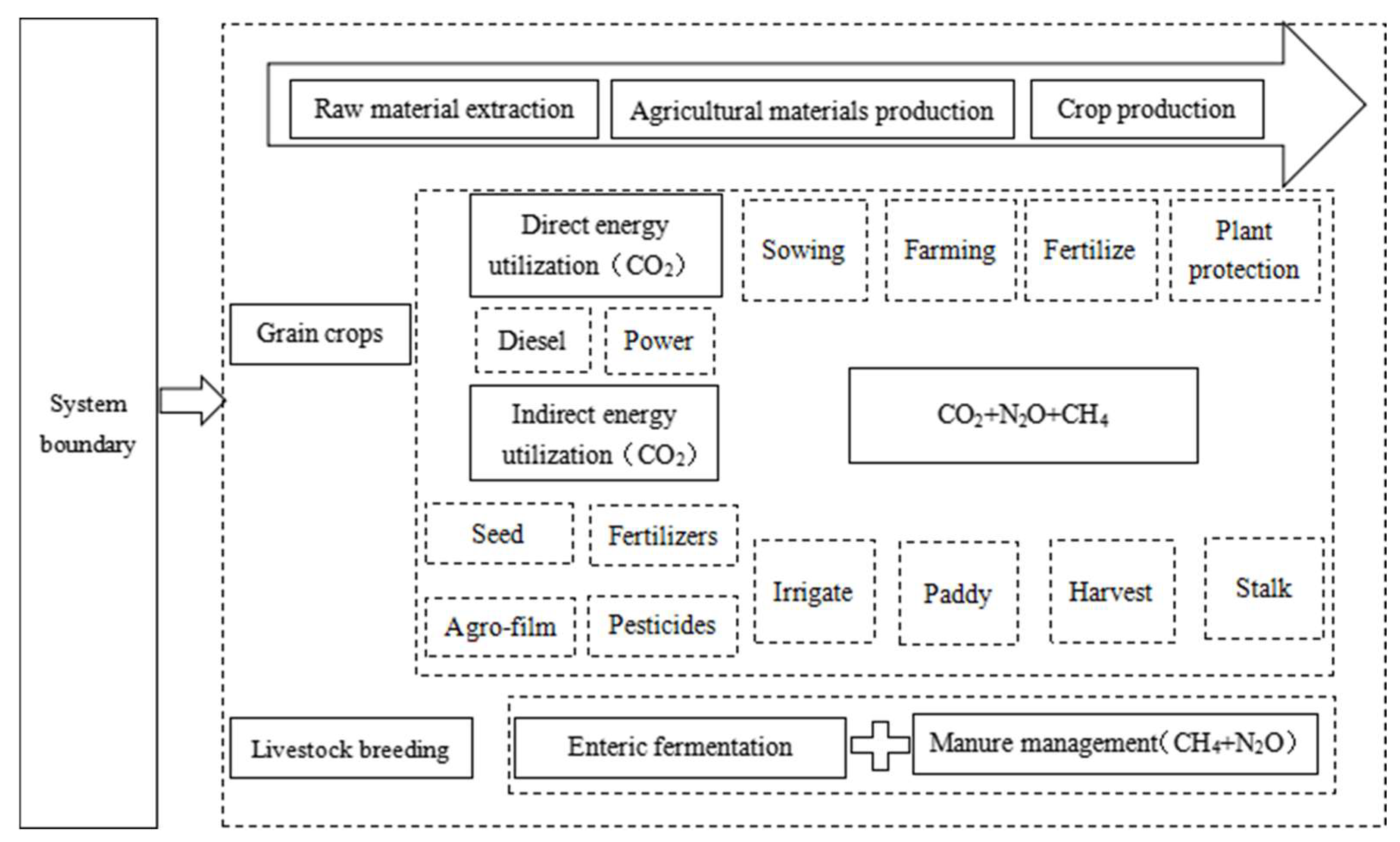
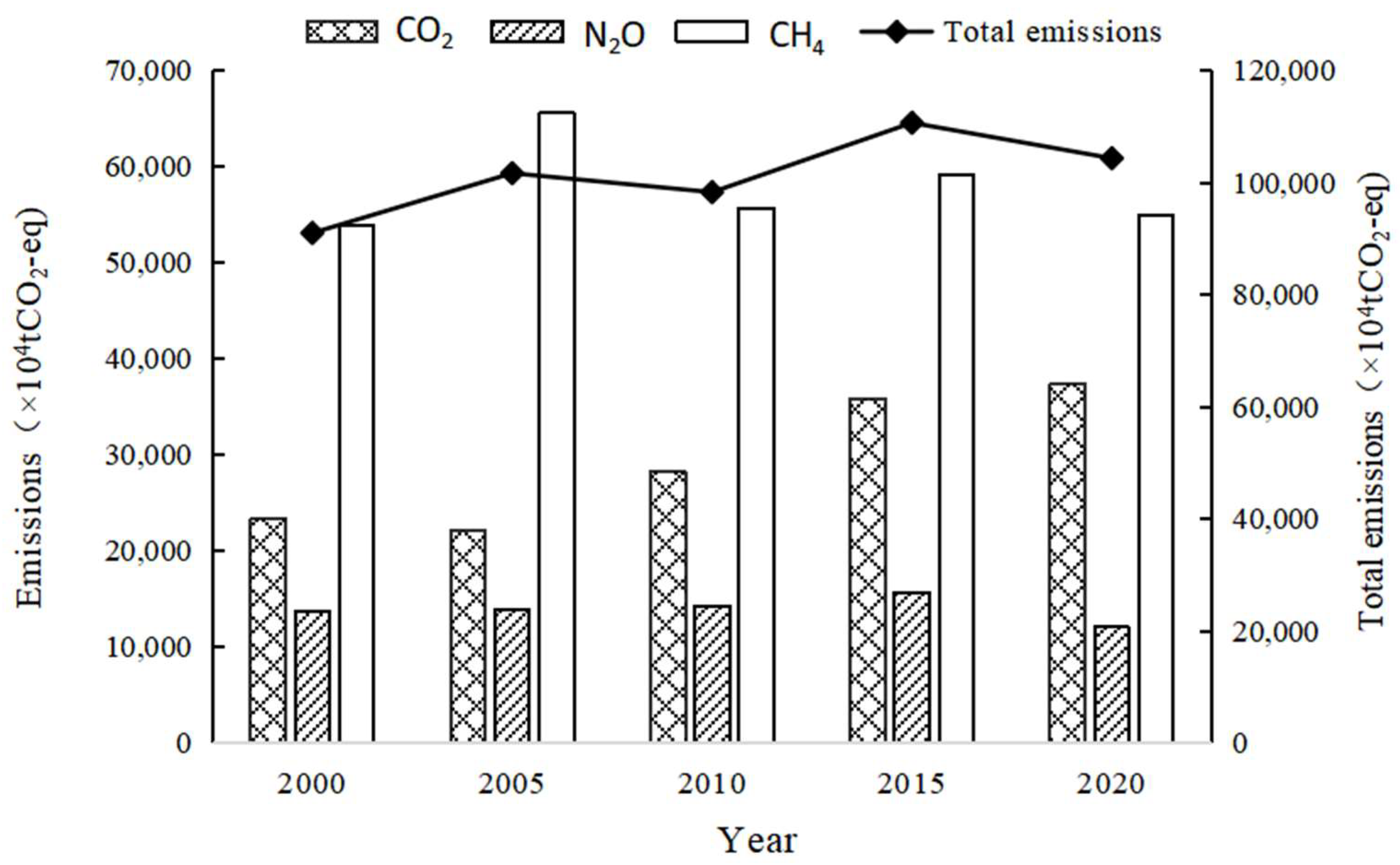
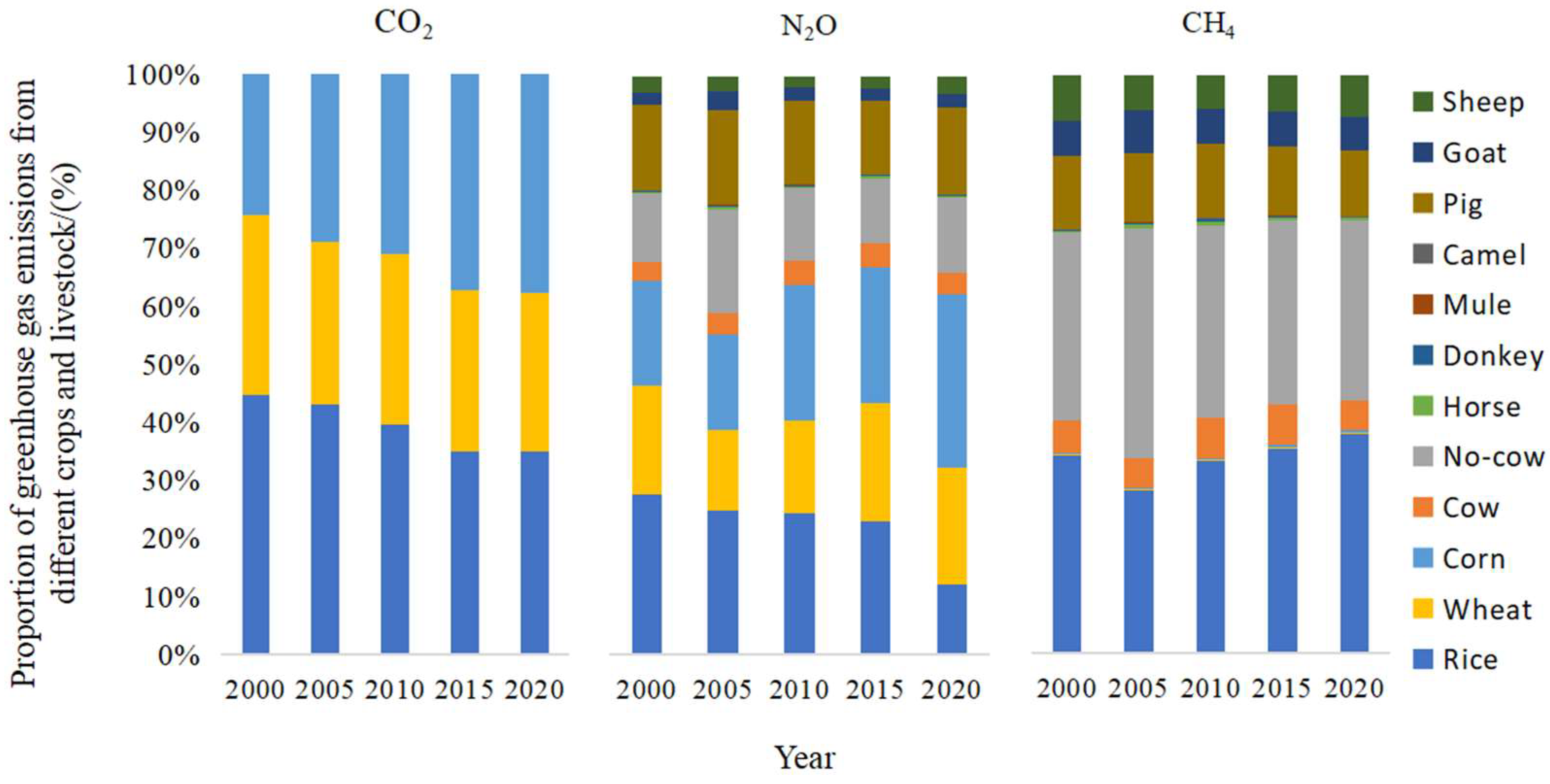
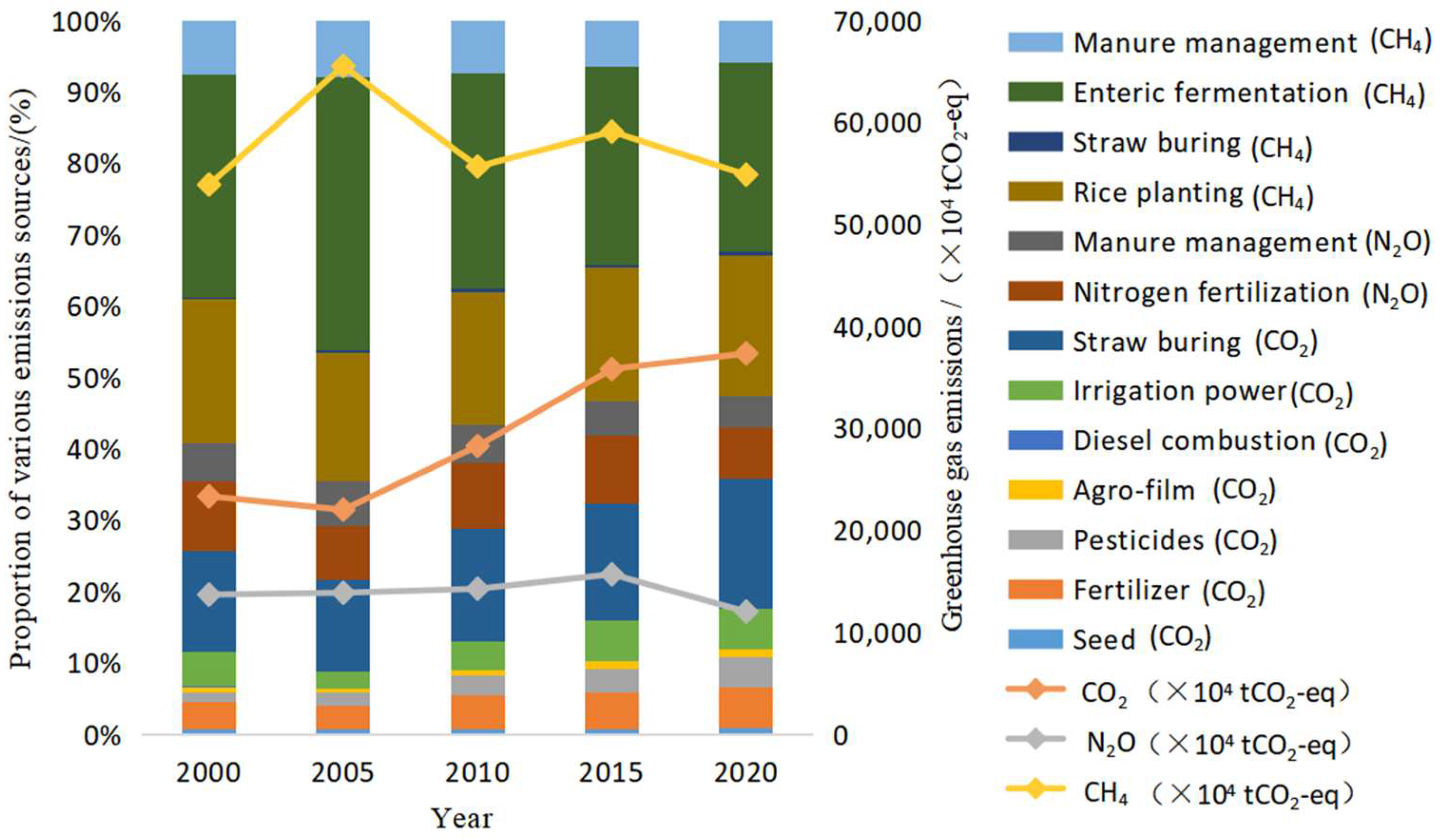
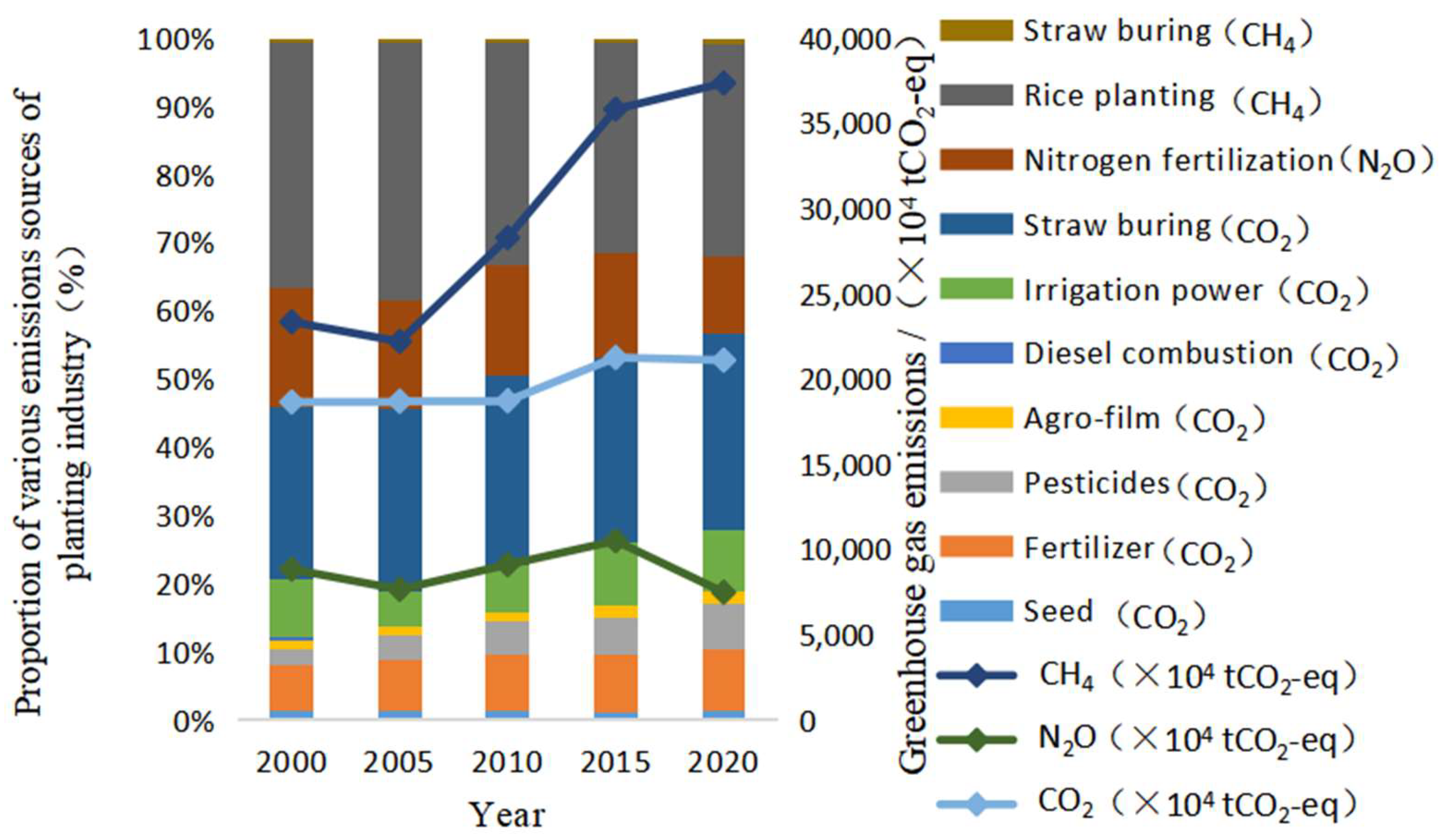
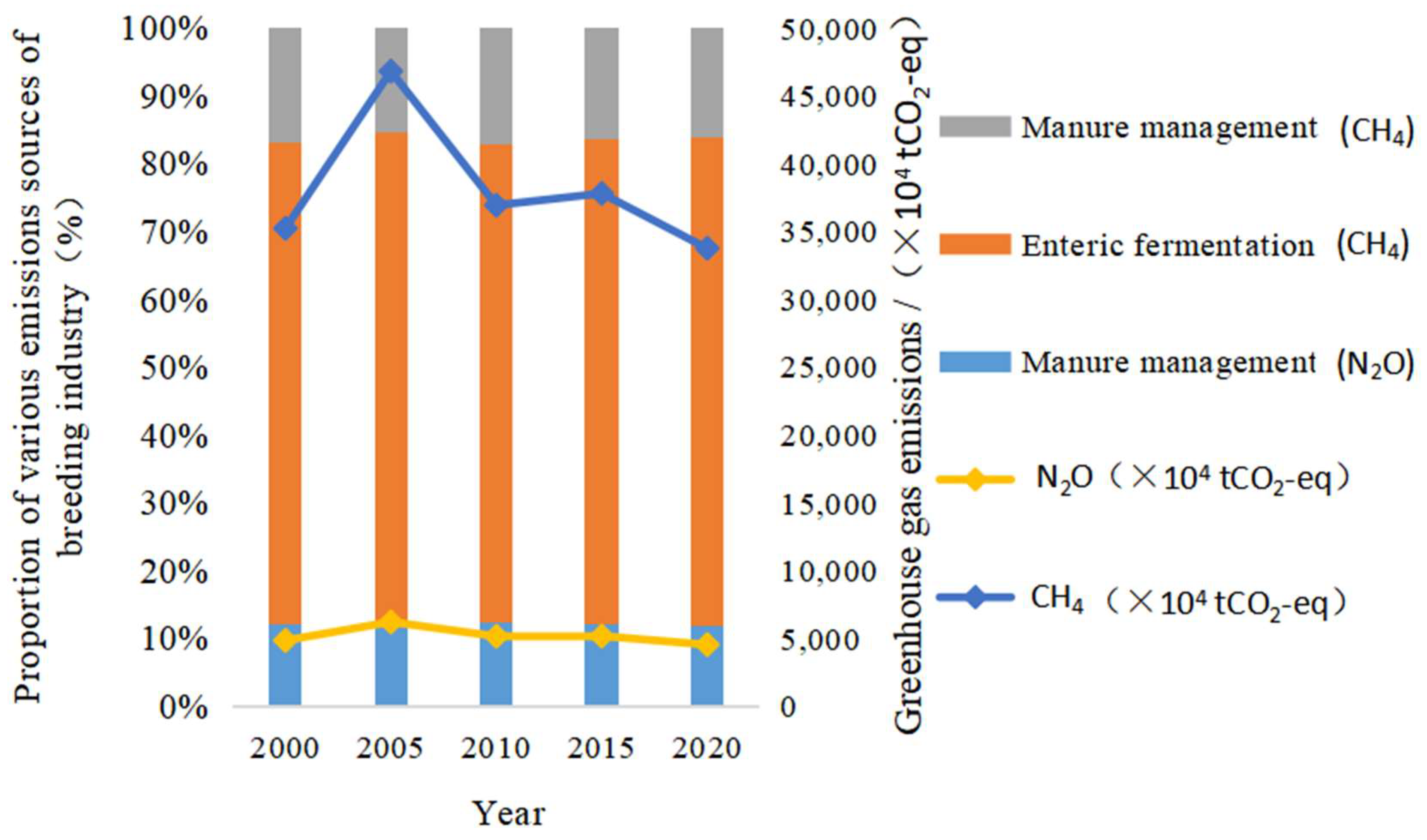
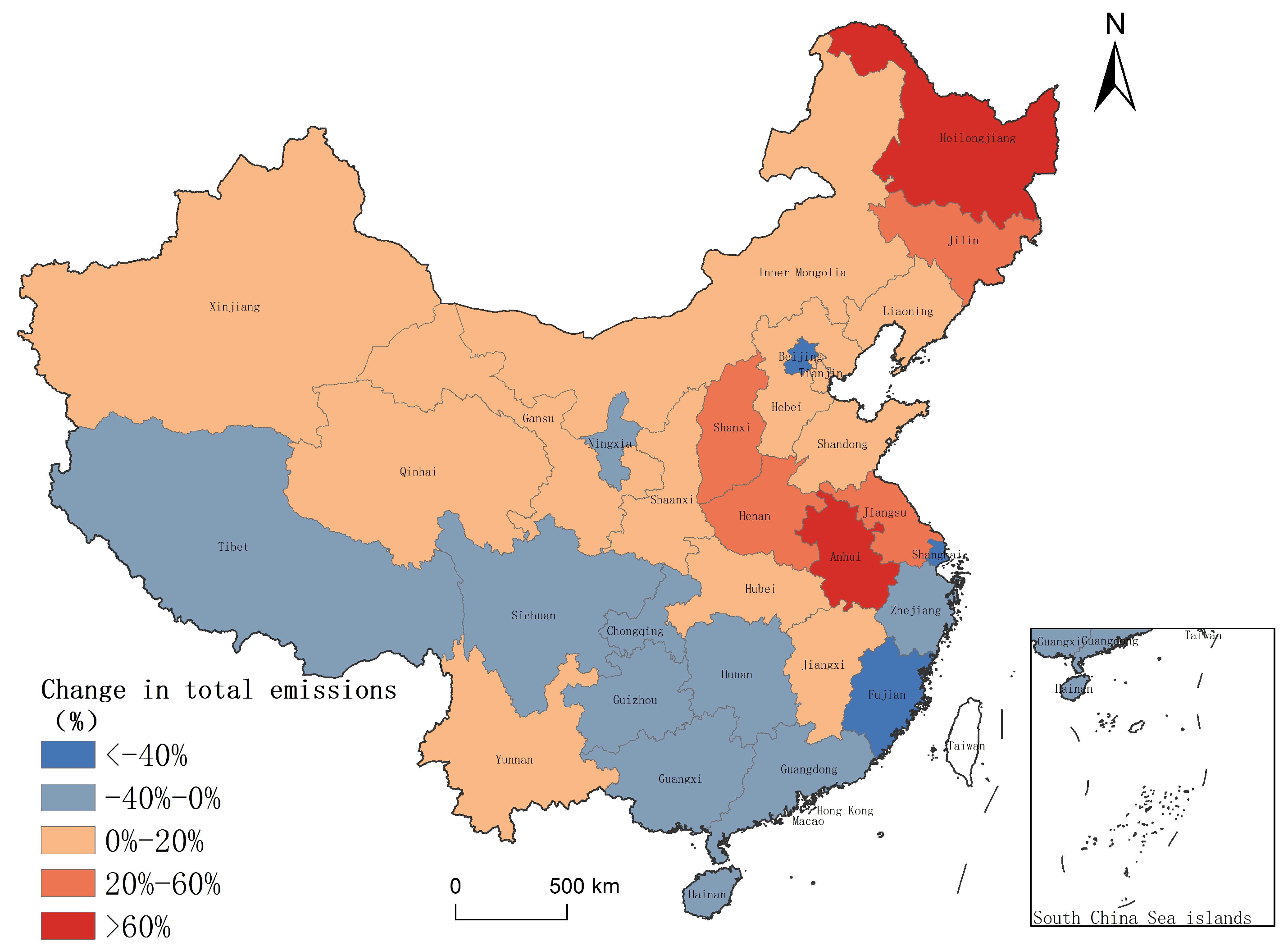

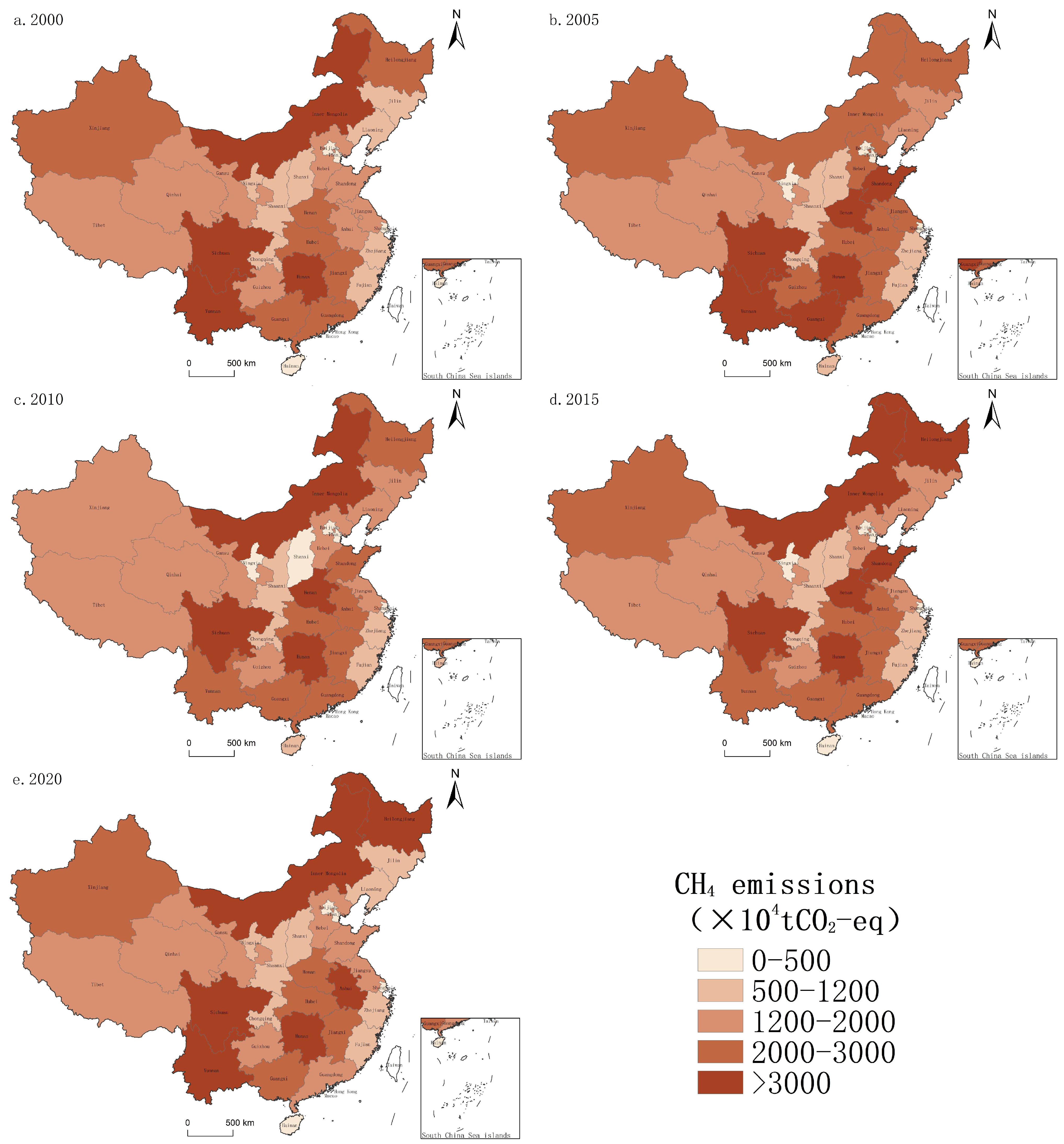
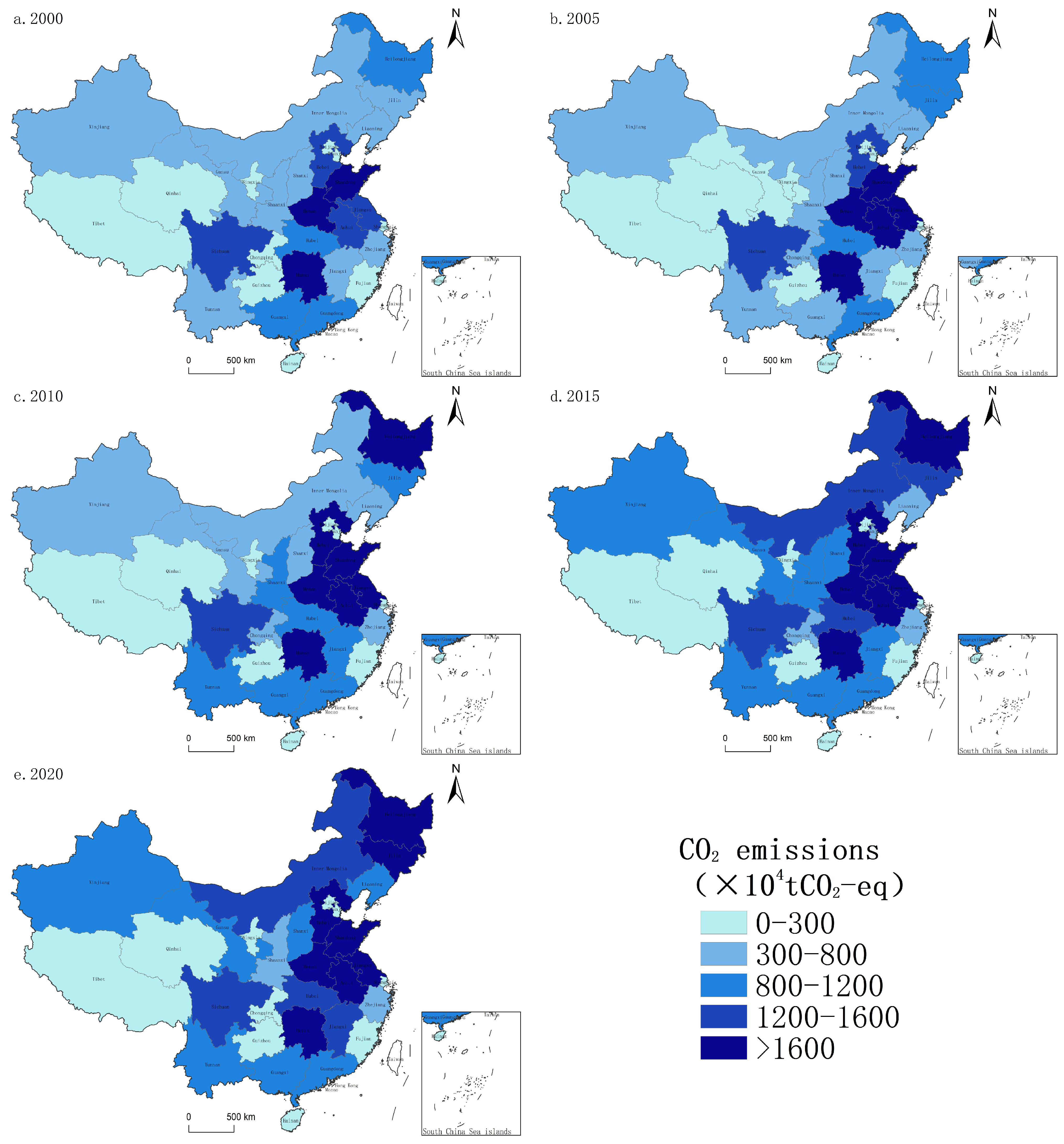
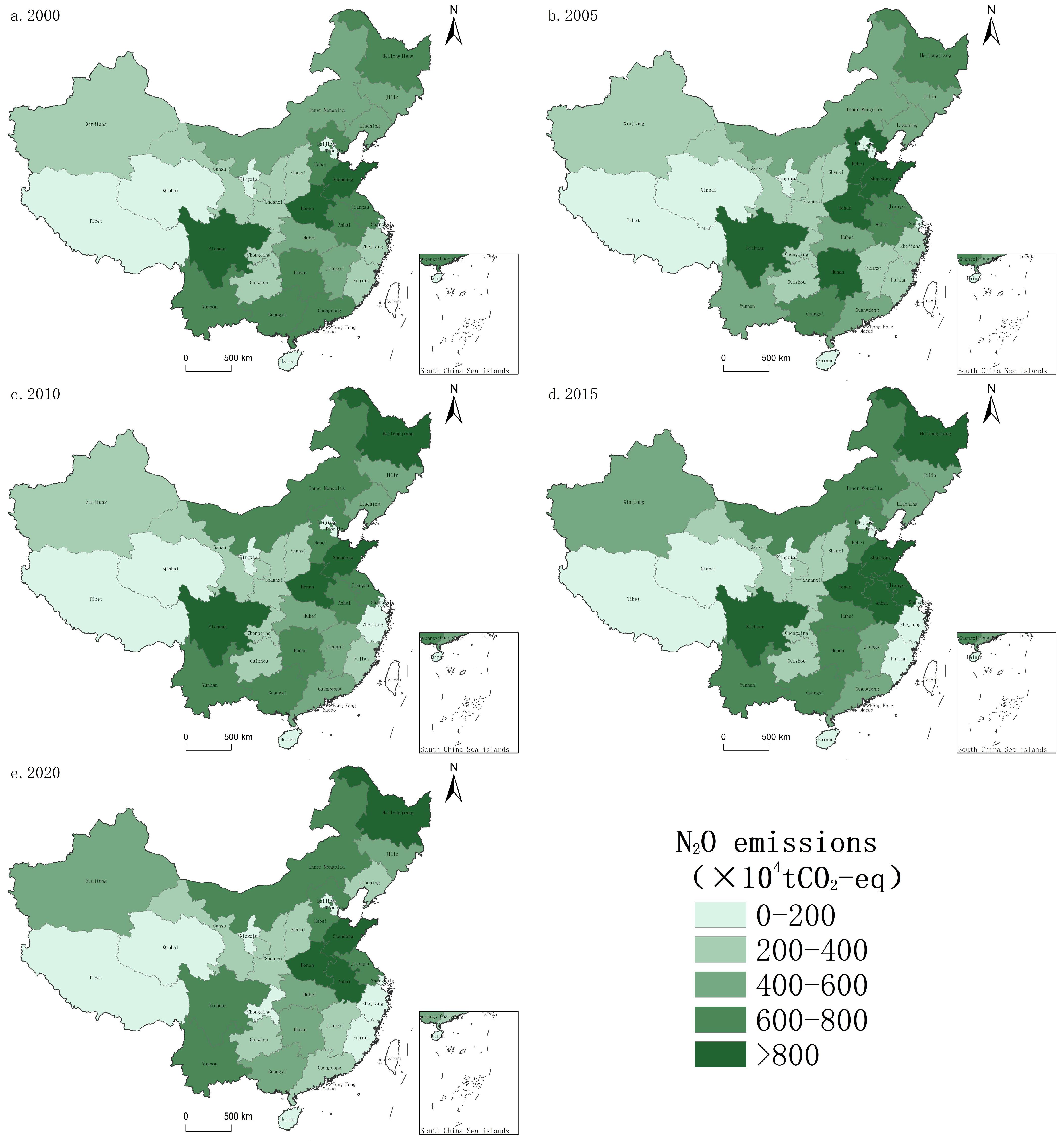
| District | Carbon Emission Coefficients | Coefficient Sources |
|---|---|---|
| Inner Mongolia, Xinjiang, Gansu, Qinghai, Tibet, Shaanxi, Shanxi, Ningxia | 0.0056 | Guidelines for the preparation of provincial greenhouse gas inventories (trial) |
| Heilongjiang, Jilin, Liaoning | 0.0114 | |
| Beijing, Tianjin, Hebei, Henan, Shandong | 0.0057 | |
| Zhejiang, Shanghai, Jiangsu, Anhui, Jiangxi, Hunan, Hubei, Sichuan, Chongqing | 0.0109 | |
| Guangdong, Guangxi, Hainan, Fujian | 0.0178 | |
| Yunnan, Guizhou | 0.0106 |
| Grain Crops | Nitrogen Content of Straw | Economic Factor | Root–Crown Ratio | Straw Return Rate |
|---|---|---|---|---|
| Rice | 0.00753 | 0.489 | 0.125 | 0.323 [47] |
| Wheat | 0.00516 | 0.434 | 0.166 | 0.765 [32] |
| Corn | 0.0058 | 0.438 | 0.17 | 0.093 [48] |
| District | Single-Season Rice | Double-Season Early Rice | Double-Season Late Rice |
|---|---|---|---|
| Beijing, Tianjin, Hebei, Shanxi, Inner Mongolia | 234.0 | — | — |
| Shandong, Shanghai, Jiangsu, Zhejiang, Anhui, Fujian, Jiangxi | 215.5 | 211.4 | 224.0 |
| Henan, Hubei, Hunan, Guangdong, Guangxi, Hainan | 236.7 | 241.0 | 273.2 |
| Sichuan, Chongqing, Guizhou, Yunnan, Tibet | 156.2 | 156.2 | 171.7 |
| Liaoning, Jilin, Heilongjiang | 168.0 | — | — |
| Shaanxi, Gansu, Qinghai, Ningxia, Xinjiang | 231.2 | — | — |
| Breeding Method | Cow | Non-Cow | Sheep | Goats | Pigs | Horse | Donkey/Mule | Camel |
|---|---|---|---|---|---|---|---|---|
| Large-scale feeding | 88.1 | 52.9 | 8.2 | 8.9 | 1 | 18 | 10 | 46 |
| Farmer feeding | 89.3 | 67.9 | 8.7 | 9.4 | ||||
| Herd | 99.3 | 85.3 | 7.5 | 6.7 |
| Animal Type | Northern China | Northwest | Eastern China | Central South | Southwestern | Northwestern | |
|---|---|---|---|---|---|---|---|
| Cow | CH4 | 7.46 | 2.23 | 8.33 | 8.45 | 6.51 | 5.93 |
| N2O | 1.846 | 1.096 | 2.065 | 1.710 | 1.884 | 1.447 | |
| Non-cow | CH4 | 2.82 | 1.02 | 3.31 | 4.72 | 3.21 | 1.86 |
| N2O | 0.794 | 0.913 | 0.846 | 0.805 | 0.691 | 0.545 | |
| Sheep | CH4 | 0.15 | 0.15 | 0.26 | 0.34 | 0.48 | 0.28 |
| N2O | 0.093 | 0.057 | 0.113 | 0.106 | 0.064 | 0.074 | |
| Goats | CH4 | 0.17 | 0.16 | 0.28 | 0.31 | 0.53 | 0.32 |
| N2O | 0.093 | 0.057 | 0.113 | 0.106 | 0.064 | 0.074 | |
| Pigs | CH4 | 3.12 | 1.12 | 5.08 | 5.85 | 4.18 | 1.38 |
| N2O | 0.227 | 0.266 | 0.175 | 0.157 | 0.159 | 0.195 | |
| Horse | CH4 | 1.09 | 1.09 | 1.64 | 1.64 | 1.64 | 1.09 |
| N2O | 0.330 | ||||||
| Donkey/Mule | CH4 | 0.60 | 0.60 | 0.90 | 0.90 | 0.90 | 0.60 |
| N2O | 0.188 | ||||||
| Camel | CH4 | 1.28 | 1.28 | 1.92 | 1.92 | 1.92 | 1.28 |
| N2O | 0.330 | ||||||
| Province | 2000 | 2005 | 2010 | 2015 | 2020 | |||||
|---|---|---|---|---|---|---|---|---|---|---|
| Total (10,000 tons) | Ranking | Total (10,000 tons) | Ranking | Total (10,000 tons) | Ranking | Total (10,000 tons) | Ranking | Total (10,000 tons) | Ranking | |
| Beijing | 126.52 | 31 | 186.21 | 31 | 168.57 | 31 | 130.23 | 31 | 48.61 | 31 |
| Shanghai | 281.87 | 29 | 202.49 | 30 | 208.55 | 30 | 191.83 | 30 | 153.28 | 30 |
| Tianjin | 258.44 | 30 | 292.59 | 29 | 254.66 | 29 | 534.25 | 29 | 293.43 | 29 |
| Chongqing | 1527.91 | 24 | 1739.50 | 22 | 1556.05 | 22 | 1564.59 | 23 | 1317.97 | 25 |
| Heilongjiang | 3720.19 | 13 | 4104.11 | 12 | 5865.46 | 4 | 7430.08 | 3 | 7007.71 | 4 |
| Liaoning | 2069.97 | 19 | 2397.21 | 18 | 2565.17 | 17 | 2638.66 | 17 | 2325.77 | 18 |
| Jilin | 2147.26 | 18 | 2867.73 | 17 | 3043.89 | 15 | 3417.13 | 16 | 3312.75 | 15 |
| Henan | 5865.67 | 3 | 8942.55 | 1 | 8494.50 | 1 | 8969.99 | 1 | 7730.59 | 2 |
| Hebei | 3742.29 | 12 | 5118.43 | 6 | 4151.15 | 11 | 4535.81 | 12 | 4196.68 | 12 |
| Hubei | 3812.47 | 10 | 4253.10 | 9 | 4267.43 | 10 | 4746.43 | 9 | 4414.23 | 11 |
| Hunan | 7384.36 | 1 | 8065.24 | 2 | 7336.22 | 2 | 7853.12 | 2 | 7255.49 | 3 |
| Shandong | 4911.74 | 4 | 6552.21 | 4 | 5467.24 | 5 | 7415.40 | 4 | 5748.97 | 6 |
| Shanxi | 1373.74 | 26 | 1601.98 | 23 | 1458.13 | 23 | 1895.00 | 21 | 1963.96 | 20 |
| Shaanxi | 1525.96 | 25 | 1841.18 | 21 | 1943.91 | 20 | 2044.90 | 20 | 1752.41 | 23 |
| Zhejiang | 1998.27 | 20 | 1571.35 | 24 | 1441.92 | 24 | 1081.50 | 26 | 1792.07 | 22 |
| Anhui | 4072.89 | 9 | 5230.80 | 5 | 5016.39 | 6 | 6541.80 | 6 | 7844.98 | 1 |
| Fujian | 1553.36 | 23 | 1531.85 | 25 | 1352.30 | 26 | 1244.08 | 25 | 889.39 | 26 |
| Jiangsu | 3344.23 | 14 | 4570.41 | 8 | 4028.44 | 13 | 5946.06 | 7 | 4938.96 | 8 |
| Jiangxi | 3791.97 | 11 | 3472.52 | 14 | 4139.65 | 12 | 4695.21 | 10 | 4535.82 | 10 |
| Guangdong | 4137.16 | 8 | 4158.29 | 11 | 3688.28 | 14 | 3708.10 | 14 | 3110.60 | 16 |
| Hainan | 632.95 | 28 | 760.10 | 27 | 700.27 | 27 | 653.18 | 28 | 451.18 | 28 |
| Sichuan | 6526.62 | 2 | 7102.36 | 3 | 6714.90 | 3 | 6698.37 | 5 | 6127.22 | 5 |
| Guizhou | 2435.42 | 17 | 3123.52 | 15 | 2498.83 | 18 | 2549.84 | 19 | 2245.73 | 19 |
| Yunnan | 4563.86 | 5 | 4169.10 | 10 | 4359.16 | 9 | 4305.16 | 13 | 4832.14 | 9 |
| Gansu | 2678.57 | 16 | 1930.02 | 19 | 2102.61 | 19 | 2608.10 | 18 | 2873.56 | 17 |
| Qinghai | 1776.64 | 22 | 1378.33 | 26 | 1430.62 | 25 | 1428.38 | 24 | 1858.10 | 21 |
| Guangxi | 4371.55 | 6 | 5085.64 | 7 | 4512.08 | 7 | 4538.58 | 11 | 3749.35 | 14 |
| Inner Mongolia | 4295.77 | 7 | 3851.86 | 13 | 4407.36 | 8 | 5088.53 | 8 | 5104.39 | 7 |
| Ningxia | 983.11 | 27 | 612.13 | 28 | 604.48 | 28 | 709.83 | 27 | 880.40 | 27 |
| Xinjiang | 3300.55 | 15 | 3070.58 | 16 | 2647.62 | 16 | 3667.66 | 15 | 3871.10 | 13 |
| Tibet | 1793.40 | 21 | 1887.76 | 20 | 1860.88 | 21 | 1829.72 | 22 | 1708.39 | 24 |
| Year | National Policy (or Event) | Influence |
|---|---|---|
| 2004 | Implementation of the “two reductions, three subsidies” policy | + |
| 2006 | Central Document No. 1 emphasizes slowing down high-emission and high-polluting agricultural inputs | − |
| 2007 | Opinions of the State Council on Promoting the Sustainable and Healthy Development of the Livestock Industry | − |
| 2008 | Central Document No. 1 emphasizes the protection of the ecological environment and the development of conservation agriculture | − |
| 2008 | The onset of the financial crisis | + |
| 2014 | Central Document No. 1 points out to accelerate the modernization of agriculture | + |
| 2015 | Law of the People’s Republic of China on Prevention and Control of Air Pollution | − |
| 2015 | Action Plan for Zero Growth in Fertilizer Use by 2020 | − |
| 2017 | The introduction of the rural revitalization strategy | − |
| 2017 | Central Document No. 1 proposes to enhance resource environmental protection and green ecological restoration work | − |
Disclaimer/Publisher’s Note: The statements, opinions and data contained in all publications are solely those of the individual author(s) and contributor(s) and not of MDPI and/or the editor(s). MDPI and/or the editor(s) disclaim responsibility for any injury to people or property resulting from any ideas, methods, instructions or products referred to in the content. |
© 2024 by the authors. Licensee MDPI, Basel, Switzerland. This article is an open access article distributed under the terms and conditions of the Creative Commons Attribution (CC BY) license (https://creativecommons.org/licenses/by/4.0/).
Share and Cite
Ning, J.; Zhang, C.; Hu, M.; Sun, T. Accounting for Greenhouse Gas Emissions in the Agricultural System of China Based on the Life Cycle Assessment Method. Sustainability 2024, 16, 2594. https://doi.org/10.3390/su16062594
Ning J, Zhang C, Hu M, Sun T. Accounting for Greenhouse Gas Emissions in the Agricultural System of China Based on the Life Cycle Assessment Method. Sustainability. 2024; 16(6):2594. https://doi.org/10.3390/su16062594
Chicago/Turabian StyleNing, Jing, Chunmei Zhang, Mingjun Hu, and Tiancheng Sun. 2024. "Accounting for Greenhouse Gas Emissions in the Agricultural System of China Based on the Life Cycle Assessment Method" Sustainability 16, no. 6: 2594. https://doi.org/10.3390/su16062594






